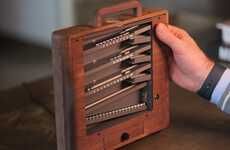
This Clock Uses a Human Eye to Represent the Passing of Time
Ellen Smith — August 2, 2017 — Art & Design
We+, a Tokyo-based contemporary design company, designed a human clock face, which uses human eyes to demonstrate the passing of time.
Giving an entirely new meaning to a "clock face," this project titled 'Patience' features a hyper-realistic and biological reiteration of the classic timepiece. The clock's eyes replace a traditional analog clock's hands -- the right eye indicates hours, while the left indicates minutes. As time passes, the eye rotates in a circular motion, appearing to move into positions a real human eye could never achieve. In addition to the clock's already bizarre facade, the mouth frequently opens and closes to represent passing seconds, creating an unsettling deviation from the clock's standard form.
This eerie and artful project represents the heavy burden time has on the human spirit and body.
Giving an entirely new meaning to a "clock face," this project titled 'Patience' features a hyper-realistic and biological reiteration of the classic timepiece. The clock's eyes replace a traditional analog clock's hands -- the right eye indicates hours, while the left indicates minutes. As time passes, the eye rotates in a circular motion, appearing to move into positions a real human eye could never achieve. In addition to the clock's already bizarre facade, the mouth frequently opens and closes to represent passing seconds, creating an unsettling deviation from the clock's standard form.
This eerie and artful project represents the heavy burden time has on the human spirit and body.
Trend Themes
1. Biological Timepieces - Creating clocks that incorporate organic elements, such as human eyes, to represent the passing of time could disrupt the traditional clock industry.
2. Hyper-realistic Design - The use of hyper-realistic design in clock faces opens up opportunities for innovative and visually captivating timekeeping products.
3. Symbolic Time Representation - Exploring alternative ways to represent the passage of time through symbolic elements, like opening and closing mouths, can offer unique and thought-provoking disruptions to conventional clock design.
Industry Implications
1. Clock Manufacturing - Clock manufacturers could explore incorporating biological elements or hyper-realistic designs in their products to capture consumer attention and differentiate their offerings.
2. Art and Design - Artists and designers can leverage hyper-realistic techniques to create visually striking timepieces that challenge traditional notions of clock aesthetics.
3. Conceptual Installations - Conceptual art installations, like the human clock face project, showcase the potential to disrupt the art world by using symbolism to explore abstract concepts like time.
6.5
Score
Popularity
Activity
Freshness























